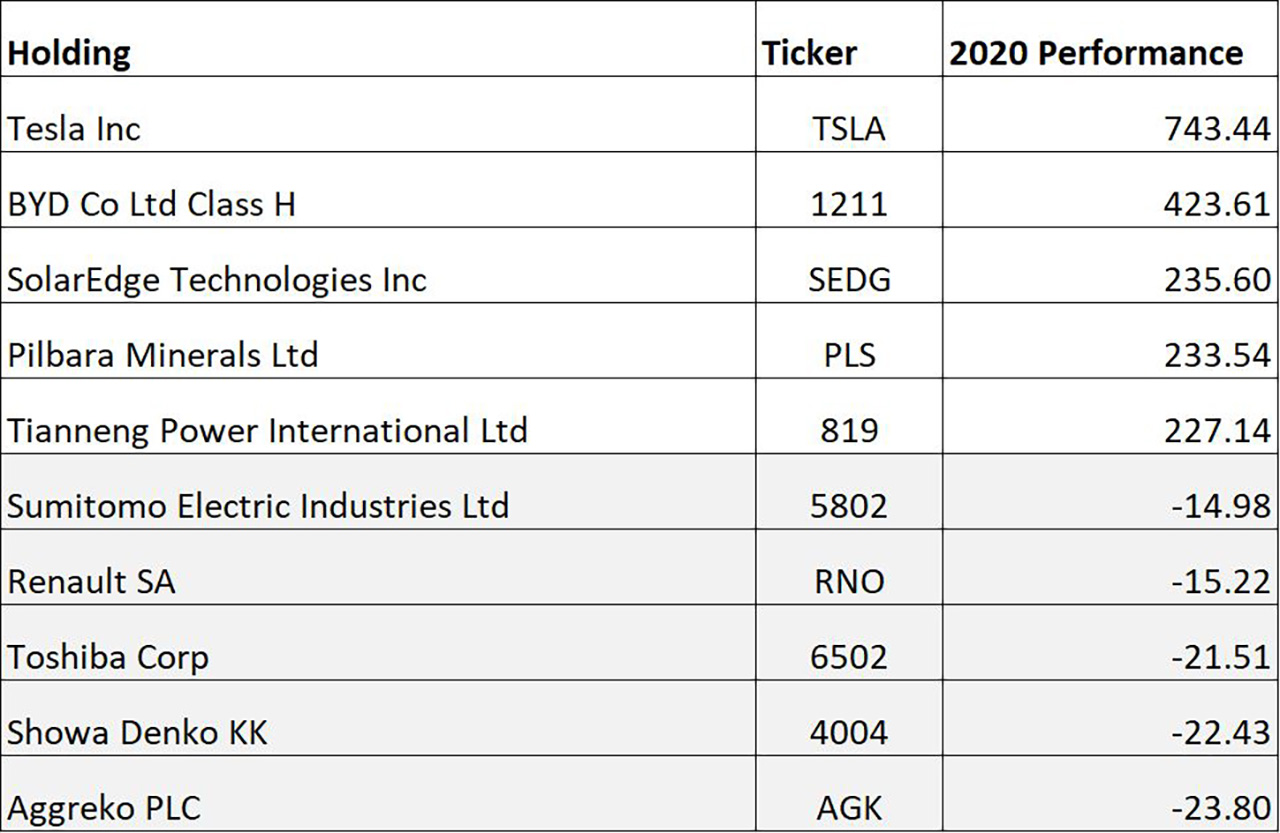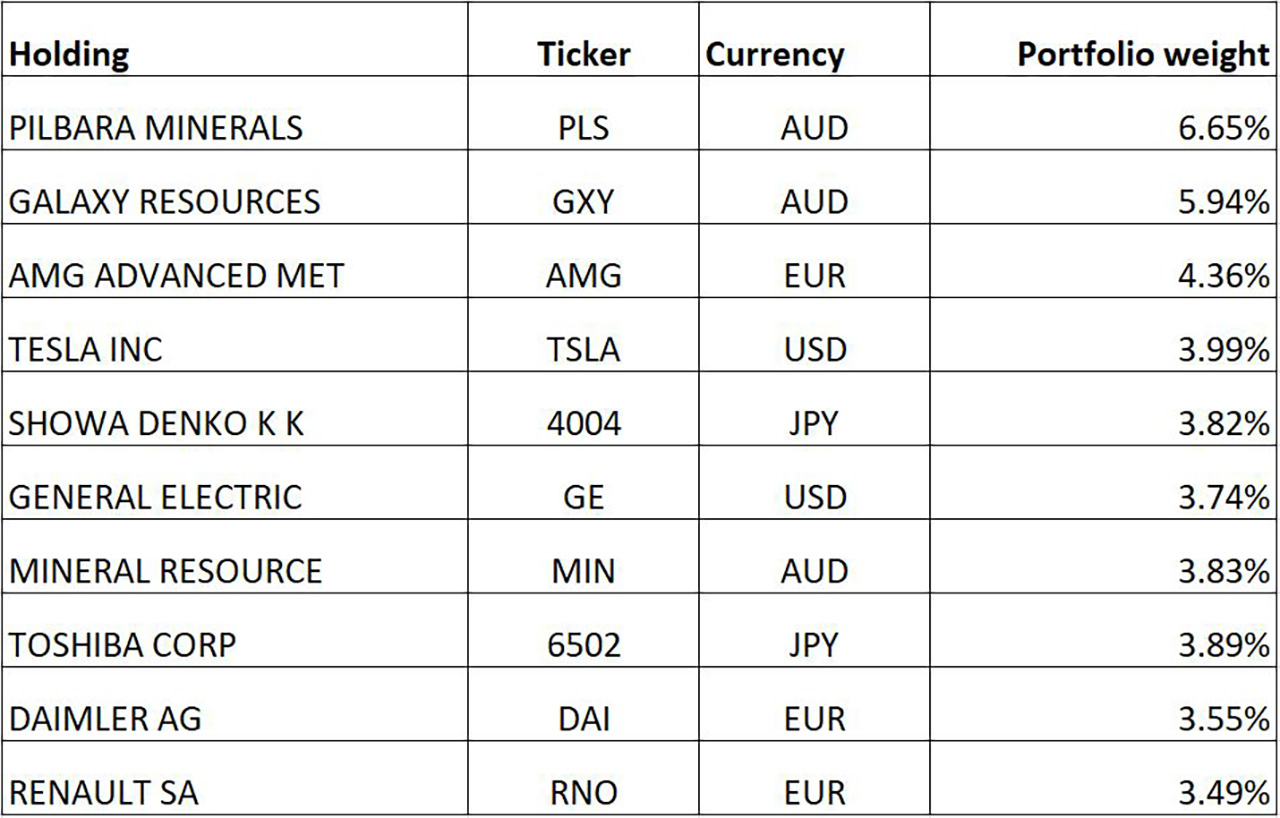Under the hood of Australia’s best performing ETF: ACDC
Fund outperformance has been driven by handful of holdings, writes Lewis Jackson.
Mentioned: HD Hyundai Electric (267260), Contemporary Amperex Technology Co Ltd (300750), Global X Battery Tech & Lithium ETF (ACDC), BetaShares Asia Technology Tigers ETF (ASIA), Tianneng Power International Ltd (00819), BYD Co Ltd (01211), Resonac Holdings Corp (4004), GS Yuasa Corp (6674), Panasonic Holdings Corp (6752), Nissan Motor Co Ltd (7201), Albemarle Corp (ALB), Brookfield Business Partners LP (BBU.UN), Bayerische Motoren Werke AG (BMW), GE Aerospace (GE), Lockheed Martin Corp (LMT), Pilbara Minerals Ltd (PLS), SolarEdge Technologies Inc (SEDG), Sociedad Quimica Y Minera De Chile SA (SQM), Tesla Inc (TSLA), Volkswagen AG (VOW)
ETFS Battery Tech and Lithium ETF (ACDC) returned an almost unbelievable 62.24 per cent last year, and investors have come running. By the end of February this year, the fund attracted more flows than it had in 2020.
ACDC offers investors exposure to energy storage and the supply chain and production for battery technology and lithium mining.
It has ridden the same wave of enthusiasm for electric vehicles (EVs) and battery storage that has seen prices rise for key raw materials like lithium and cobalt. Cobalt is up 155 per cent since Jan 2020, according to the London Metal Exchange.
The fund is filled with familiar names. Automakers like Tesla (TSLA) and Nissan Motor Co (7201), and conglomerates like Toshiba (6502), Panasonic (6752), and General Electric (GE).
But there are plenty of unfamiliar and unexpected faces. Lithium miner Pilbara Minerals (PLS), or pureplay battery producer GS Yuasa Corp (6674) might be unfamiliar to outsiders, while Lockheed Martin (LMT), of F-35 fighter jet fame, or asset manager Brookfield BP-U (BBU.UN) are well known, if unexpected inclusions.
Today, we dig into the fund to help investors understand what it is they are holding, and the prospects for this popular space.
Performance in perspective
ADCD's performance in 2020 speaks for itself, but the numbers are less meteoric going back several years. The fund launched in August 2018, but the index it replicates, Solactive Battery Value-Chain, goes back to December 2017. The fund (or its tracking index) underperformed the MSCI World Index – used in the ETFS factsheet – in 2018 and 2019.
Total return (%) of $100 invested at the start of each year till year end
Source: Morningstar Direct
Several star performers helped drive the fund’s 2020 return. Ten firms out of the fund’s 31 had a cumulative return of over 100 per cent.
Automakers Tesla and BYD (01211) returned 743.44 per cent and 423.61 per cent respectively. Solar panel maker Solaredge (SEDG), Pilbara Minerals, and battery maker Tianneng Power International (00819) each returned over 200 per cent.
On the other end, the fund had 10 holdings with negative returns. Toshiba Corp, chemical firm Showa Denko KK (4004), and power generation equipment firm Aggreko PLC (AGK) all lost more than 20 per cent.
Top and bottom 5 performers within ACDC holdings
Source Morningstar Direct
Strong performance gathered increasing interest from investors. Total flows for 2020 were $47 million. Year to date flows have already hit $95 million, according to ETFS.
The fund is one of several popular thematic ETFs to have done well recently. Technology focused BetaShares Asia Technology Tigers ETF (ASIA) returned 62 per cent in 2020.
The maximum management fee for ACDC is 0.69 per cent of the net asset value. To be this in context, the average maximum fee across ETFs (index tracking) in Morningstar's Global Equity category is 0.40 per cent.
Morningstar analysts do not cover this fund.
A closer look at the holdings
As of 14 April, the fund has holdings across 31 companies, spread over 12 countries. The top ten holdings, which account for 43.26 per cent of the fund, are shown below.
Almost 50 per cent of the total holdings are listed in Japan or the United States. Japanese companies make up almost a third of the fund’s holdings.
Top 10 ACDC holdings by weight
Source ACDC PCF. Downloaded 16 April
The fund offers investors exposure to the entire EV and energy storage supply chain. For Morningstar senior equity analyst Seth Goldstein, this is a good way to approach investing in EV adoption.
“You get exposure to everything from the basic materials such as lithium through batteries and through the actual auto original equipment manufacturers (OEMs) themselves.”
We step through three important parts of that supply chain, lithium mining, batteries, and EVs, looking at some of the inclusions and omissions.
Lithium miners
As of April 14, the fund’s two largest holdings by weight were ASX listed pure-play lithium producers Pilbara Minerals and Galaxy Resources (GXY). Both firms control lithium mines in Western Australia, among other places.
They’ve both experienced meteoric rises since 1 October 2020, with Pilbara Minerals clocking in 309.57 per cent, and Galaxy Resources 198.38 per cent.
Large players in lithium mining are missing though, says Goldstein. Firms like Albemarle (ALB), the world’s largest producer of lithium, or Chilean giant Sociedad Quimica y Minera de Chile (SQM).
Narrow moat Albemarle closed on Thursday at US$150.52, above Morningstar's fair value estimate of US$140. Narrow Moat SQM closed on Thursday at US$54.10, just below Morningstar's fair value estimate of US$55.
Lithium prices have gone through two major cycles in the last six years, says Goldstein. A lack of supply saw lithium prices begin to rise around 2015 and 2016. Higher prices incentivized more production and by 2018 this has begun to outpace demand.
“Resource extraction - it's never a fine balance between supply and demand like we learn in economics class," he says. "One side tends to be much greater than the other for a number of a few years…”
“We saw prices boom from 2016 to 2018, then go bust and fall from 2018 to 2020. And now we're in a period where prices bottomed at the end of 2020 and are now rising quickly again.”
MORE ON THIS TOPIC: Thematic ETFs: short-lived trend or long-term investment?
Goldstein is bullish about lithium demand going forward. It’s still the lightest metal that can store enough energy to make EVs a commercially viable proposition.
“In the transportation sector, lithium-based batteries are the only thing I see as a viable technology over the next decade, if not the next two to three decades.”
The fund’s mining holdings are primarily lithium focused. The other commodities that go into electric batteries, like Cobalt or Nickel, aren’t directly represented. That might be a good move from a risk perspective says Goldstein.
“There might be some more risk with elements like cobalt or nickel. Different battery chemistry could use more or less of those raw material which could affect demand and prices… There isn't a great pure play option for either of these commodities that isn't a very small-scale junior miner that carries its own company specific risks.”
Batteries
The fund includes 17 firms involved in battery production. This ranges from smaller pure-play producers like GS Yuasa, and specialised industrial firms like Hyundai Electric (267260), to sprawling conglomerates like Toshiba Corp.
The range exposes the misconceptions we have around batteries says ETFS head of Distribution Kanish Chugh.
“It's that stereotype that battery technology gets. Everyone goes Tesla and cars. But when we talk battery technology it could be further down the line in grid storage.”
This helps explain some of the stranger looking inclusions, firms like Lockheed Martin or Brookfield BP-U. In addition to building the F-35, the former is working on a new battery technology called “flow battery.” The latter is responsible for energy storage systems.
Investors should keep in mind that growing demand for electric vehicles won’t necessarily translate into greater profits at battery manufacturers says Goldstein.
“Automakers are continually asking them to reduce their prices so they can sell cheaper EVs. You're risking battery maker profits won't match the growth profile of EV adoption.”
Automakers
Electric vehicles are where most consumers will engage with energy storage. The fund holds six automakers, including investor-darling Tesla, luxury brand BMW (BMW), and mass market Nissan Motor Co.
It also includes lesser known Chinese manufacturer BYD, which Caradvice reports has just signed an agreement to sell a fully electric vehicle in Australia from next year.
Nissan Motor Co closed on Thursday at 582.30 yen, a 61 per cent discount on Morningstar’s fair value estimate of 1480 yen. At the other end of the spectrum, Tesla closed at US$ 738.85, a 112 per cent premium on the fair value estimate of US$349. BYD is outside Morningstar coverage.
With a stable of six automakers, investors might be surprised to see Volkswagen (VOW) excluded. The firm has recently been making a big push into EVs, including a botched April fools rebrand to “Voltswagen.”
Investor enthusiasm over its plans has seen the firm’s share price rise 60.46 per cent year to date. It closed on Thursday at US$33.94, just above Morningstar's fair value estimate of $30.
Chugh says the exclusion makes sense once you consider the fact Volkswagen is sourcing their batteries from LG Chem, which is already part of the fund’s holdings.
The fund also holds Solaredge Techno, which in addition to being a dominant player in the US solar panel market, is working to build out the charging infrastructure which will support EVs.
Is the bright future priced in?
Goldstein remains bullish about growth in the electric vehicle space, forecasting that by 2025 EVs will reach cost and functional parity with combustion engines. By 2030, he expects EVs and hybrids to be one out of every two cars sold globally.
“EV adoption was 3-4 per cent last year, if we go to 20 per cent in 2030, that's 4 to 6 times the number of electric vehicles sold each year. In order to do that we're going to need a lot more batteries and a lot more lithium. I think the market's taking a very forward-looking approach and has finally connected the dots.”
Investors will need to consider how much of that future has been priced in already. Car makers like Volkswagen or Tesla are trading at or above their Morningstar fair value estimates. The same goes for lithium miners like SQM or Albemarle.
As with every growth technology, weigh the risks and opportunities carefully.




